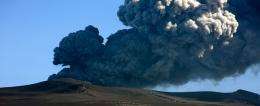Researchers use lightning detection for early warning of volcanic ash

(PhysOrg.com) -- New Zealand scientists are playing a key role in developing a new system to give early warning of aviation-endangering volcanic eruptions by detecting the lightning their ash clouds trigger.
The system, publicly unveiled by US researchers today, uses data from the World Wide Lightning Location Network (WWLLN) to create automated email alerts within minutes of suspiious lightning activity occurring near volcanoes.
The WWLLN was founded by now retired University of Otago Professor Richard Dowden, and the computer code for generating the new system’s alerts was written by Dunedin-based Otago PhD graduate Dr James Brundell.
Otago Physics researcher Dr Craig Rodger, who leads New Zealand’s WWLLN activities, says the early warning system is an exciting development for both the network and in helping to ensure safer skies.
“In some of the world’s remote regions that otherwise lack good monitoring of volcanic activity, this system could pick up the slack and allow local aviation early warning of potentially hazardous ash plumes,” Dr Rodger says.
In October this year, the system proved its potential by giving the first indication of an eruption of a volcano in Kamchatka in the Russian Far East. An hour before the ash cloud appeared in satellite images, an automatic email was sent to Dr Brundell and researchers from the University of Washington and the U.S. Geological Survey, he says.
The system involves monitoring lightning strokes occurring around all of the world’s 1500 or so volcanoes, as well as more distant lightning from each volcano (up to 100km) to help determine if new strokes over the volcano are possibly weather related.
Because weather-related lightning is very common in many parts of the world where volcanoes are found, only those in Alaska, the Marianas, and the Russian Far East are currently assigned to the automatic real time alerts, he says.
“To avoid ‘crying wolf’, local meteorological conditions in other regions would need to be more carefully checked before any warnings were issued,” he says.
Dr Rodger says that the warning system is one of the latest in a multitude of research avenues enabled by WWLLN, which has grown into an international consortium of over 60 universities and government laboratories.
The network’s 50 stations that underpin the warning system stretch across the globe,
including sites in Dunedin and New Zealand’s Antarctic Scott Base. The stations consist of Very Low Frequency (VLF) radio receivers that register the pulses created by lightning from up to 10,000 kilometres away.
Their data is constantly sent over the internet to two central processing computers – one at the University of Washington in Seattle and the other at the University of Otago – which calculate the location of lightning strikes by triangulating pulse reports from several stations.
Scientists from the University of Washington and the U.S. Geological Survey announced the ash cloud warning tool today at the American Geophysical Union’s Fall Meeting, the largest gathering of Earth scientists in the world.
More information: wwlln.net/
Provided by University of Otago

















